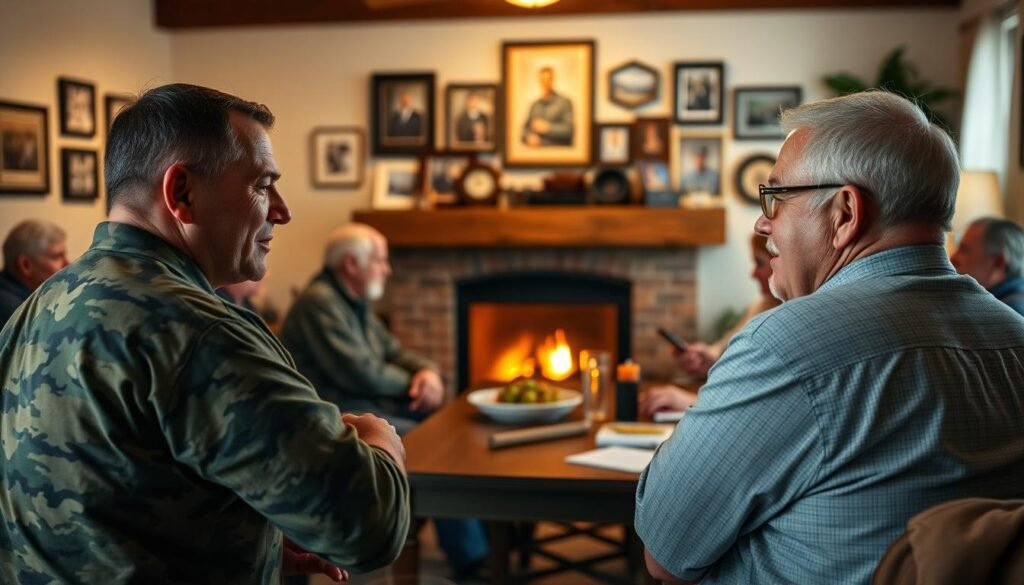The story begins on a cool autumn morning when a group of veterans gathered at a firehouse for a skills day. One former team leader carried a worn map and a quiet confidence. He tuned his voice to an audience of curious neighbors and fellow service members.
The room listened as he described how training in high-stress missions helped him find purpose after active duty. That spark led many in the group toward public safety work and a new sense of belonging in civilian life.
This Resource Hub outlines the path veterans take during the often-complex transition. It covers assessment, credential translation, targeted training, and employer fit. Readers will learn where recruitment fits and how health and family support shape long-term success.
For a practical example of a national shift from uniformed to civilian-operated rescue, see the UK search-and-rescue review, which highlights operational change and lessons learned.
Key Takeaways
- Many veterans find mission-driven work in public safety aligns with military skills.
- Successful transition often needs credentialing, targeted training, and mentorship.
- Health, family, and community support are critical for long-term stability.
- Understanding employer fit—municipal, state, federal, or nonprofit—guides career choices.
- Communication gaps between hiring teams and service members can be closed with evidence-based tools.
Understanding The Transition Into Civilian Life And SAR Careers
For hundreds of specialties, the end of active duty begins with a careful mapping of skills to civilian jobs. Transition is a phased process: assessment, training, and work trials that reveal where mission focus fits best in community safety.
Translating rank, billets, and documented achievements into measurable competencies prevents mismatch. Examples include incident management, field leadership, medical first response, and unmanned systems expertise.
Transition assistance and each formal transition program provide baseline resources and civilian work exposure. Many find gaps appear a year after separation, so ongoing mentoring and targeted training matter.
The differences between military service and civilian organizations affect daily operations: credentialing, budgets, liability rules, and volunteer versus paid models shape expectations.
Document deployments, exercises, and inspections as verifiable evidence for hiring panels. Early engagement with regional agencies, emergency management offices, and volunteer teams helps validate fit before commitment.
Build a resource stack: mentors, training providers, peer groups, and mental health supports. These elements sustain momentum through separation and during the next career phase.
- Map skills to clear outcomes and certifications.
- Use transition assistance to create a multi-year plan.
- Engage local agencies early to test organizational fit.
Why Search And Rescue Attracts Transitioning Veterans
Individuals with ground combat backgrounds often look for careers that mirror the trust and tempo of their units. Service driven motives—purpose, teamwork, and duty—make field rescue a natural fit for many veterans.
Field-tested skills translate well. Navigation, small-unit leadership, radios, air-ground integration, convoy ops, and casualty evacuation map directly to search planning, swiftwater work, and wilderness medical response.
Career opportunities span municipal fire rescue, sheriff’s teams, state task forces, federal incident crews, and NGOs. Each path has different credentialing, advancement tracks, and employment models.
Operational tempo and training cycles feel familiar. Shift patterns, on-call demands, and stipend versus salary models influence total compensation and family planning. Mentors and peer groups provide vital support while balancing life needs.
- Test environments with ride-alongs, volunteer teams, or shadow days.
- Document skills and seek counselors who match strengths beyond narrow job lists.
- Evaluate offers for duties, benefits, and long-term growth.
For context on aviation support in emergency work, see this piece on helicopter operations: helicopter emergency operations.
Mapping Military Skills To Civilian Rescue Roles
A clear competency map turns logistics, communications, and medical tasks from military jargon into job-ready strengths.
Operations, logistics, intelligence, communications, aviation crew, CBRN, and medical map to distinct job families: field search, rope teams, swiftwater, incident command, and medical response.
Hiring managers often want outcomes, not rank. Recast readiness metrics as measurable wins: response times improved, training throughput increased, or equipment downtime reduced.
Align field credentials to civilian standards — NASAR SARTECH, EMT/Paramedic, Rope Rescue, Swiftwater, FEMA ICS — and list them prominently on the resume.
- Use tools and resources such as skills translators and frameworks (STAR/SOAR/CAR) to convert mission records into clear claims.
- Balance hard skills (navigation, rope systems) with soft skills (team leadership, risk communication, interagency coordination).
- Avoid overemphasizing rank; show cross-functional outcomes instead.
Tailor each application to the job announcement. Mirror employer language and selection criteria to pass automated screens and reach decision makers.
Challenges Transitioning Veterans Face In Civilian Employment
Many veterans report that hiring teams often misread their records, creating a gap between capability and opportunity.
Employer bias and assumptions about temperament or cultural fit can undervalue skills. Stereotypes about overqualification or rigidity block interviews before they begin.
Language differences add friction. Military acronyms and role titles rarely match civilian job descriptions. That gap makes it hard for service members to show measurable impact.
Translating outcomes into clear workforce value reduces underemployment. Employers respond to metrics: saved costs, improved readiness, faster response times.
Self-promotion feels unfamiliar for many. Structured formats—STAR stories, quantified bullets, and peer-reviewed resumes—help candidates present impact without discomfort.
When formal programs fall short, targeted assistance works. Military OneSource and peer mentors fill gaps in networking, credential planning, and program selection.

| Challenge | Impact | Practical Fix |
|---|---|---|
| Employer Bias | Screen-outs, fewer interviews | Use outcome-focused resume language and third-party endorsements |
| Language Gap | Misaligned job matches | Translate acronyms to civilian competencies; mirror job post terms |
| Credential Gaps | Slow hiring, conditional offers | Enroll in modular training and stackable certifications |
| Networking Discomfort | Limited referrals | Practice pitch with mentors and use structured networking programs |
Evaluate any program by tracking mentor access, placement rates, and post-placement follow-up. That lens helps meet real needs and limit early attrition.
Overcoming Initial Recruitment And Hiring Barriers
Early screening often filters out capable candidates before a live conversation ever happens.
To counter this, start with a tight resume that mirrors the vacancy language used by hiring managers. Use AI-enabled resume tools and federal-format support when applicable to surface relevant terms and metrics.
Step-by-step:
- Translate duties into outcomes: list response times, training throughput, safety metrics, and readiness rates.
- Align keywords with the job posting so applicant tracking systems pass the file to recruiters.
- Prepare a concise narrative that demonstrates steady temperament, adaptability, and teamwork.
“Structured translation of achievements and targeted networking reduce early screening loss and increase interview chances.”
Exploit available programs, resources, and tools: mentors, alumni groups, AI job-match platforms, and targeted outreach to emergency management associations. These channels produce higher-signal leads than high-volume job boards.
| Barrier | Practical Fix | Expected Result |
|---|---|---|
| ATS Keyword Miss | Use AI tools to map vacancy language to resume bullets | Higher pass rates to recruiter review |
| Unconscious Bias | Leverage third-party endorsements and outcome metrics | Increased interviews with hiring managers |
| Low-Signal Applications | Target alumni, SAR units, and emergency associations | Better interview-conversion ratios |
For interviews, use a simple behavior framework: Situation, Action, Result. Practice three field-based stories that show judgment and accountability. Follow up with a brief, polite cadence: thank-you note at 24 hours, a two-week check-in, and one referral request if no decision arrives.
Adjusting To Civilian Workplace Culture In The SAR Environment
Adjusting to a civilian chain of command often feels less linear than a service structure and demands fresh social skills.
Decentralized decision-making, cross-agency coordination, and certification-driven advancement shape everyday norms. Veterans should learn how certifications map to pay and rank, and how agencies reward documented competency rather than rank alone.
Practical steps help speed integration. Seek diverse training partners, volunteer on task forces, and enroll in continuing credential programs to align expectations and build credibility.
Performance feedback and supervisory styles can be blunt or slow. Expect formal reviews, public recognition systems, and budget-based limits on promotions. Managing these realities reduces frustration.
Micro-behaviors build trust fast: transparent communication, tidy documentation, after-action humility, and proactive safety checks. These small acts ease cultural friction and show respect for local norms.
Peer support and mentoring buffer role-identity shifts and reduce burnout during life changes. Use internal learning programs to learn governance, budgets, and community relations that influence outcomes.
“Adapting core values while learning new social rules accelerates employment success and long-term service satisfaction.”

From Military to SAR: Transitioning Into Civilian Rescue Roles
Most veterans complete the move successfully, though some face situational or longer-term reintegration needs.
A practical pathway begins with a tight self-inventory, informational interviews, and targeted field practicums. Those steps feed into credential stacking, probationary assignments, and measurable outcomes that hiring teams value.
Employers range across municipal, county, state, federal, and nonprofit models. Each has different culture, governance, and mission scope. Service members should match expectations to lifestyle and geographic limits before committing.
Combine formal program training with volunteer hours to show commitment and reduce hiring risk. Peer mentors, alumni networks, and local SAR captains often translate that credibility into offers.
“Continued service framed as mission alignment signals resilience under austere conditions.”
Use a compact decision framework: weigh speed-to-hire against long-term growth, credential portability, and family needs. Focus on humility, safety culture, and interagency collaboration—qualities that veterans bring when presented clearly.
- Self-inventory → Informational interviews → Field practicums
- Stack credentials + volunteer experience
- Leverage mentors and local networks for referrals
Mentorship Networks That Accelerate The Transition
Structured mentoring shortens the learning curve and opens doors that cold applications rarely reach. Mentors translate field achievements into clear, employer-focused claims and provide warm introductions that lead to relevant interviews.
Core networks combine scale and personal attention. Veterati offers unlimited 1-hour mentorship calls for targeted coaching. eMentor links service members, veterans, and spouses with advisors for resume and interview help. American Corporate Partners (ACP) provides longer one-on-one relationships for in-depth career planning.

USAA, Military Talent Partners, And Heroes Linked
USAA supplies mentoring tools that streamline scheduling and tracking. Military Talent Partners focuses on placement for veterans and spouses. Heroes Linked is a web app that matches advisors to specific regional hiring dynamics.
GallantFew, Boots To Shoes, And Bunker Labs
GallantFew combats isolation with hometown mentors. Boots To Shoes pairs veterans with local business leaders. Bunker Labs supports entrepreneurship—useful for those exploring alternative paths before formal employment.
Academy Women, PAVE, MBA Veterans Network, And Veterans Mentor Network
These groups strengthen representation and campus support. The Veterans Mentor Network is a 130K+ LinkedIn community that connects students, alumni, and employers for advanced leadership tracks.
Stand Beside Them And The Commit Foundation
Stand Beside Them coaches both veterans and spouses. The Commit Foundation offers high-touch assistance to help veterans find purpose and smooth a veterans transition.
- Identify three goals: resume, credential mapping, interview prep.
- Line up one short call, one project mentor, and one local connector.
- Reciprocate: offer time to others and share lessons learned.
Organizations And Programs Supporting Civilian Employment
A compact catalog of national and regional programs helps veterans match goals with realistic job pipelines.
USO Pathfinder offers one-on-one planning across education, employment, financial wellness, and mentoring. RecruitMilitary pairs candidates with employers and hosts frequent job fairs that widen employer access.
VETS2INDUSTRY and Centurion Military Alliance curate free resources and run workshops on vocation and financial literacy. Veteran Jobs Mission and The Catalyst illustrate employer coalitions and intensive curricula that boost placement and retention.
Groups such as DAV and CASY drive pipelines through resume labs and direct matching. SVA and SHIFT convert campus supports and fellowships into credible on-the-job experience. Veterans ASCEND, Warrior To Work, Hire Heroes, Return 2 Work, and Veterans Transition Support tailor outreach and vocational planning.
| Organization | Focus | Format | Best For |
|---|---|---|---|
| USO Pathfinder / RecruitMilitary | Planning; employer access | One-on-one; job fairs | Early transition planning |
| VETS2INDUSTRY / Centurion | Resources; workshops | Curated learning | Skill discovery |
| Veteran Jobs Mission / The Catalyst | Placement & retention | Coalition; intensive course | Employer-led hiring |
| VCTP (IVMF) / Leader Transition Institute | Certs; identity-focused training | Online; short residencies | Certification pathways |
Readers should mix national platforms, local centers, and virtual options based on timelines and target sectors. Layered use of programs and resources improves employment outcomes and builds a resilient career plan.
Tools And Databases To Translate Service Into A Civilian Job
A deliberate chain of tools—from skills translators to mock interviews—creates a measurable path to hire. This section shows how to use available platforms as a workflow. The aim is to move from raw experience to a tailored resume and stronger offers.
Step 1: Translate. Use the Military Skills Translator and CareerOneStop’s Military To Civilian Occupation Translator to map MOS/AFSC/Rating to target roles, needed certifications, and keywords for SAR-style applications.
The Resume Engine And My Next Move
Next, build a civilian-ready resume with The Resume Engine. Pair that with My Next Move interest profiles to confirm match by industry and duties.
Glassdoor And Interview Research
Validate language and compensation using Glassdoor. Study company reviews and interview question libraries before live interviews.
Transition Intelligence Dashboard And Lessons Learned Database
Use the Transition Intelligence Dashboard for data on frequent transition questions. Cross-check with the Lessons Learned database to spot patterns that predict success.
Candorful Interview Coaching And Koch’s Veteran Transition Guide
Finish with practice and strategy. Candorful provides mock interviews. Koch’s Veteran Transition Guide supplies negotiation scripts and offer playbooks.
“Translate, Target, Tailor, Practice, Negotiate — use data at every step to raise interview conversion and offer quality.”
- Translate MOS into civilian keywords and certs.
- Target roles with My Next Move and local job ads.
- Tailor the resume using The Resume Engine and Glassdoor phrasing.
- Practice with Candorful and log lessons in the database.
- Negotiate using Koch’s playbook and market data.
| Tool | Primary Use | Best Outcome |
|---|---|---|
| Military Skills Translator / CareerOneStop | Role mapping; keywords | Clear target list and certification plan |
| The Resume Engine | Translate experience to civilian resume | ATS-friendly, outcome-focused resume |
| Glassdoor | Company research; interview questions | Realistic pay and interview prep |
| Transition Intelligence Dashboard / Lessons Learned | Data trends; veteran insights | Evidence-based decisions on fit |
| Candorful / Koch’s Guide | Interview coaching; negotiation | Stronger offers and confidence |
Practical tip: Chain these tools and programs with official transition assistance or a transition assistance program such as Military OneSource to ensure documentation and benefits align with the employment plan.
Training And Education Pathways For SAR And Beyond
Practical coursework combined with on-the-ground rotations builds measurable readiness for emergency teams. This section explains clear steps that help service members use formal programs and apprenticeships to prove day-one value.
DoD SkillBridge Opportunities
DoD SkillBridge enables eligible service members to join civilian training, apprenticeships, or internships for up to six months before separation.
Use SkillBridge to arrange supervised rotations timed with seasonal demand. Negotiate placements that mirror the job you expect after separation.
Vets2PM And Professional Certifications
Vets2PM converts operational leadership into project management credentials and places veterans with employers who value field experience.
Stack certifications—EMT/Paramedic, Rope/Confined Space, Swiftwater, UAV Part 107, ICS 100–800—to document competence and shorten ramp time.
- Blend coursework and field training to show verified outcomes.
- Use GI Bill or employer tuition assistance to fund certs and time management.
- Document training for employer verification and measurable impact.
“Stacked credentials and supervised civilian rotations reduce hiring risk and increase retention.”
| Pathway | Benefit | Best Use |
|---|---|---|
| DoD SkillBridge | Supervised civilian experience | Pre-separation job mirroring |
| Vets2PM | PM certs + employer placement | Leadership to career mobility |
| Certification Stack | Documented day-one readiness | Field teams and emergency management |
Building A Civilian Resume That Resonates With Hiring Managers
A well-crafted resume turns operational readiness into measurable business value that hiring managers can trust.

Translating Operational Readiness Into Business Impact
Use a simple conversion formula: readiness rate × frequency = output gain. Then map that gain to cost avoidance, throughput, or downtime reduction.
Example: “Improved mission readiness 18% across three units, cutting equipment downtime by 22% and saving an estimated $120K annually.”
Quantifying Achievements For Civilian Employers
Structure the resume: summary, core competencies, quantified bullets, and certifications. Bullets should include numbers, percentages, and timeframes.
Mirror job language to improve ATS results and make each bullet speak to operations, safety, or financial impact.
Showcasing Leadership, Logistics, And Risk Management For SAR
Reframe logistics and risk work as process improvements: “Coordinated multi-agency response reducing average incident time by 35%.” This shows ICS fluency and cross-agency value.
- Checklist: ATS keywords, certifications listed, 3–5 quantified bullets per role, concise summary.
- Use third-party validations and clear metrics for faster hiring decisions by hiring managers.
“Translate readiness into measurable outcomes that speak the language of business.”
Leveraging Technology And AI To Reduce Transition Friction
Machine learning tools can surface veteran strengths hidden by service jargon and make them visible to hiring teams.
AI-driven parsing and matching turn service records, training logs, and certificates into searchable, employer-friendly profiles. These systems use NLP to map MOS-style language to civilian job descriptions, raising qualified candidates in applicant pools where the wording differs.
AI Resume And Job Match Tools For Faster Placement
Generative AI and resume builders speed drafting and improve relevance for specific job posts. They shorten time-to-interview by aligning achievements with employer language and by auto-populating federal-style sections when needed.
Practical tip: Combine AI suggestions with a mentor review to ensure technical accuracy for mission-critical positions.
Mitigating Bias And Improving Veteran Hiring Outcomes
Research shows well-designed AI can reduce bias compared with unaided human review. That benefit depends on safeguards: transparency, regular bias audits, and a human-in-the-loop for final decisions.
“Responsible AI paired with human oversight increases interview rates and improves placement quality for veterans.”
- Ethical AI checklist: transparency, audit logs, bias tests, and human review.
- Use structured data—certifications, deployments, training hours—to improve match accuracy.
- Deploy dashboards to track program metrics: time-to-hire, interview conversion, and veterans transition outcomes.
Business case: Investing in responsible AI reduces hiring friction, broadens access, and raises placement quality for transitioning personnel while lowering recruitment costs for business partners.
Navigating Family, Community, And Support Systems
Rebuilding daily routines around duty cycles and family needs is central to any successful reintegration. Clear schedules, shared expectations, and mapped benefits reduce friction when on-call duties arrive.
Reintegration depends on individual, interpersonal, community, and societal factors. Anxiety and isolation tied to posttraumatic stress can block social reconnection unless a strong support plan exists.
Service members and veterans should include partners in planning. Align childcare, transportation, and contingency duties before the first activation.
- Treat the move as a family event: share schedules, benefits, and expectations early.
- Map common stressors: identity shifts, community reintegration, and uncertainty—then link to local peer networks.
- Normalize care: mental health literacy and early referrals are part of professional readiness.
- Document emergency contacts, insurance, and local support assets.
- Agree on childcare and transport contingencies with a partner or neighbor.
- Set predictable recovery periods after high-tempo operations and tell supervisors.
Mutual aid and volunteerism translate service traditions into community engagement that strengthens family resilience. Use mentors to guide conversations about work-life balance and long-term transition planning.
“A proactive household plan turns uncertainty into predictable routines that sustain career and family life.”
Connecting With Career Opportunities In The Civilian Workforce
Practical exposure accelerates hiring. Short fellowships, targeted job fairs, and skills-matching platforms reveal which employers reward operational experience.
SHIFT fellowships offer three-month industry experiences with clear conversion opportunities. Veterans ASCEND pairs veterans to employers based on skills. RecruitMilitary hosts large job fairs that place candidates before hiring decision-makers.
Use a weekly pipeline: one focused application, one informational interview, and one event or practice session. That routine converts leads into interviews and builds momentum.
“Treat fellowships and fairs as on-ramps—test culture, timeline, and credential fit before accepting an offer.”
Compare options by timeline, credential needs, compensation, and growth. Rank offers by mission fit, long-term prospects, and organizational stability—not just starting pay.
- Blend full-time roles, three-month fellowships, and volunteer-to-hire paths.
- Use job fairs and skills platforms to gather market intelligence.
- Follow a networking cadence: outreach, follow-up, and referral requests.
| Option | Typical Timeline | Best Use |
|---|---|---|
| Full-Time Agency Role | Weeks–Months | Stable pay, credentialed paths |
| SHIFT Fellowship | 3 months | Fast conversion to industry partners |
| Volunteer-To-Hire | Months | Local credibility; seasonal teams |
- Script: “I bring documented field outcomes, certifications, and a three-month availability window for training.”
- Negotiate flexibility by proposing a coverage plan and cross-trained backup.
Conclusion
Sustained momentum comes from a simple routine: mentor calls, targeted training, and focused outreach to hiring champions.
Action steps matter. Build a mentor bench, use skills translators and interview tools, and pick programs that match mission needs.
Translate service into clear civilian career value by quantifying outcomes and proving day-one readiness.
Anticipate challenges and use Military OneSource, peer networks, and responsible AI solutions to navigate culture and hiring systems.
Keep learning: stack credentials, cross-train, and pursue leadership growth. Align family priorities and life goals with duty cycles and benefits.
Quick Checklist: review mentors, confirm programs, log interviews, and track onboarding steps until stable employment and long-term resilience.



